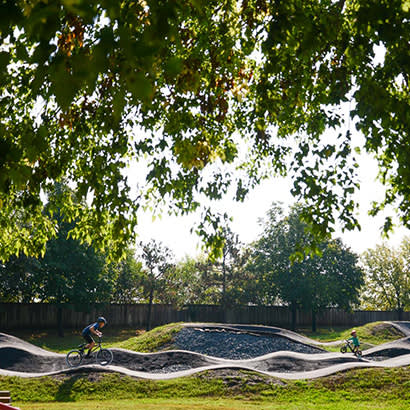
For an enhanced digital experience, read this story in the ezine.
Growing biodiversity alongside recreational amenities
Nestled between a freeway sound wall and an alley, Perkins Hill Park is a small Minneapolis park serving a culturally diverse neighborhood and the students from the adjacent City View Elementary School. During the past few years, the community has worked with Minneapolis Park and Recreation Board (MPRB) staff to develop a renovation plan for Perkins Hill. They identified and prioritized amenities, naming a new playground, pump track and pollinator habitat to the top of the list.
As the first pump track in the city, it opened to accolades by people of all ages and abilities. The well-used track allows newer riders to learn how to maintain their momentum, take the curves and enjoy the speed. What didn’t get accolades was the green space along the pump track’s edges. While the slopes of the track had been seeded to establish pollinator habitat, the germination rate was poor, and it wasn’t long before weeds took over and everything had to be mowed down.
A serendipitous announcement by NRPA, offering a grant opportunity from the Danaher Foundation to support biodiversity, supplied the spark to pursue an enhanced pollinator planting project. With funding from the Danaher Foundation and approved plans in hand, habitat work should begin in the spring of 2024 once the frost is out of the ground.
Planting for Pollinators
To ensure success, this pollinator planting will include a biodegradable weed barrier and mulch, and plugs of flowers and grasses will be planted instead of seeds. Once established, the habitat will benefit pollinators and birds and will be enjoyed by park visitors, pump-track spectators and track users. MPRB asset management staff view the pollinator project as a win. It will eliminate the need for mowers to navigate the steep slopes, reduce erosion and help prevent rogue paths from forming along the edges of the pump track.
Teenagers participating in the MPRB’s summer youth employment and training program will help care for the pollinator habitat. This was a major factor when designing the project. Instead of a complex prairie planting, a simplified plant palette will feature blooms from spring to fall and be planted in large color blocks. This approach will make it easier for teenagers to identify desirable plant species and feel more confident while weeding. Teens will participate in community science work — such as the Backyard Bumble Bee Count — learn to use iNaturalist and discover the actions they can take at home to benefit pollinators.
Enhancing Onsite Education
The project also includes enhancement of onsite interpretation. A primary focus will be the park’s shipping container, which stores a fleet of bikes and helmets that neighborhood children and youth may use for free. The shipping container will feature large-scale photo banners highlighting native plants and pollinators, as well as the importance of pollinators — especially in their caterpillar state — to nourish baby birds. Did you know it takes 6,000 to 9,000 caterpillars to raise a single clutch of chickadees?
In addition to onsite interpretation, MPRB Environmental Education staff are excited at the prospect of readily accessible pollinator habitat to feature as part of Drop-In Discovery (DID). DID programs are led by a naturalist who engages any youth playing in the park in nature-based investigation. These are free programs, and no registration is required so that all children may participate. This style of program is ideal for park spaces that do not have a staffed building or regular programming. Guided exploration of the pollinator habitat will help children foster wonder and curiosity about nature and help us grow the next generation of park stewards.
MaryLynn Pulscher is Manager of Environmental Education and Youth Employment at the Minneapolis Park and Recreation Board.

